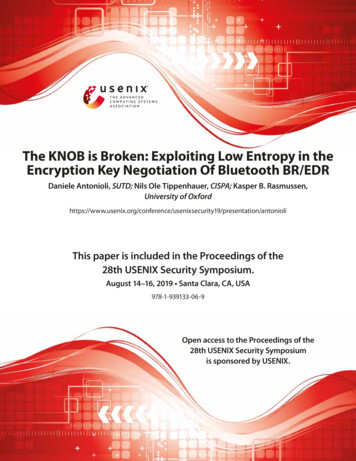
Transcription
The KNOB is Broken: Exploiting Low Entropy in theEncryption Key Negotiation Of Bluetooth BR/EDRDaniele Antonioli, SUTD; Nils Ole Tippenhauer, CISPA; Kasper B. Rasmussen,University of rity19/presentation/antonioliThis paper is included in the Proceedings of the28th USENIX Security Symposium.August 14–16, 2019 Santa Clara, CA, USA978-1-939133-06-9Open access to the Proceedings of the28th USENIX Security Symposiumis sponsored by USENIX.
The KNOB is Broken: Exploiting Low Entropy in the Encryption Key NegotiationOf Bluetooth BR/EDRDaniele AntonioliSingapore University ofTechnology and DesignNils Ole TippenhauerCISPA Helmholtz Centerfor Information SecurityKasper RasmussenDepartment of Computer ScienceUniversity of Oxforddaniele landkasper.rasmussen@cs.ox.ac.ukAbstractWe present an attack on the encryption key negotiation protocol of Bluetooth BR/EDR. The attack allows a third party,without knowledge of any secret material (such as link andencryption keys), to make two (or more) victims agree on anencryption key with only 1 byte (8 bits) of entropy. Such lowentropy enables the attacker to easily brute force the negotiated encryption keys, decrypt the eavesdropped ciphertext,and inject valid encrypted messages (in real-time). The attackis stealthy because the encryption key negotiation is transparent to the Bluetooth users. The attack is standard-compliantbecause all Bluetooth BR/EDR versions require to support encryption keys with entropy between 1 and 16 bytes and do notsecure the key negotiation protocol. As a result, the attackercompletely breaks Bluetooth BR/EDR security without beingdetected. We call our attack Key Negotiation Of Bluetooth(KNOB) attack.The attack targets the firmware of the Bluetooth chip because the firmware (Bluetooth controller) implements allthe security features of Bluetooth BR/EDR. As a standardcompliant attack, it is expected to be effective on any firmwarethat follows the specification and on any device using a vulnerable firmware. We describe how to perform the KNOBattack, and we implement it. We evaluate our implementationon more than 14 Bluetooth chips from popular manufacturers such as Intel, Broadcom, Apple, and Qualcomm. Ourresults demonstrate that all tested devices are vulnerable tothe KNOB attack. We discuss countermeasures to fix theBluetooth specification and its implementation.1IntroductionBluetooth BR/EDR (referred for the rest of this paper asBluetooth), is a short-range wireless technology widely usedby many products such as mobile devices, laptops, IoT andindustrial devices. Bluetooth provides security mechanismsto achieve authentication, confidentiality and data integrity atthe link layer [6, p. 1646].USENIX AssociationThe security and privacy of Bluetooth has been attackedand fixed several times, going all the way back to Bluetooth v1.0. [15, 32]. Several successful attacks on the (securesimple) pairing phase [28, 13, 4] have resulted in substantialrevisions of the standard. Attacks on Android, iOS, Windowsand Linux implementations of Bluetooth were also discussedin [2]. However, little attention has been given to the securityof the encryption key negotiation protocol, e.g., the Bluetoothsecurity overview in the latest Bluetooth core specification(v5.0) does not mention it [6, p. 240].The encryption key negotiation protocol is used by twoBluetooth devices to agree on the entropy of the link layerencryption key. Entropy negotiation was introduced in thespecification of Bluetooth to cope with international encryption regulations and to facilitate security upgrades [6, p. 1650].To the best of our knowledge, all versions of the Bluetoothstandard (including the latest v5.0 [6]) require to use entropyvalues between 1 and 16 bytes. The specification of Bluetooth states this requirement as follows: “For the encryptionalgorithm, the key size may vary between 1 and 16 octets (8 128 bits)” [6, p. 1650]. Our interpretation of this requirementis that any device to be standard-compliant has to supportencryption keys with entropy varying from one to sixteenbytes. The attack that we present in this work confirms ourinterpretation.The encryption key negotiation protocol is conducted between two parties as follows: the initiator proposes an entropyvalue N that is an integer between 1 and 16, the other partyeither accepts it or proposes a lower value or aborts the protocol. If the other party proposes a lower value, e.g., N 1,then the initiator either accepts it or proposes a lower value orit aborts the protocol. At the end of a successful negotiationthe two parties have agreed on the entropy value of the Bluetooth encryption key. The entropy negotiation is performedover the Link Manager Protocol (LMP), it is not encryptedand not authenticated, and it is transparent to the Bluetoothusers because LMP packets are managed by the firmware ofthe Bluetooth chips and they are not propagated to higherlayers [6, p. 508].28th USENIX Security Symposium1047
In this paper we describe, implement and evaluate an attackcapable of making two (or more) victims using a Bluetoothencryption key with 1 byte of entropy without noticing it. Theattacker then can easily brute force the encryption key, eavesdrop and decrypt the ciphertext and inject valid ciphertextwithout affecting the status of the target Bluetooth piconet.In other words, the attacker completely breaks BluetoothBR/EDR security without being detected. We call this attackthe Key Negotiation Of Bluetooth (KNOB) attack.The KNOB attack can be conducted remotely or by maliciously modifying few bytes in one of the victim’s Bluetoothfirmware. Being a standard-compliant attack it is expectedto be effective on any firmware implementing the Bluetoothspecification, regardless of the Bluetooth version. The attacker is not required to posses any (pre-shared) secret material and he does not have to observe the pairing process ofthe victims. The attack is effective even when the victimsuse the strongest security mode of Bluetooth (Secure Connections). The attack is stealthy because the application usingBluetooth and even the operating systems of the victims cannot access or control the encryption key negotiation protocol(see Section 3.2 for the details).After explaining the attack in detail, we implement it leveraging our development of several Bluetooth security procedures to generate valid link and encryption keys, and theInternalBlue toolkit [21]. Our implementation allows a manin-the-middle attacker to intercept, manipulate, and drop LMPpackets in real-time and to brute force low-entropy encryption keys, without knowing any (pre-shared) secret. We havedisclosed our findings about the KNOB attack with CERTand the Bluetooth SIG, and following that, we plan to release our tools as open-source at https://github.com/francozappa/knob. This will enable other Bluetooth researchers to take advantage of our work.We summarize our main contributions as follows: We develop an attack on the encryption key negotiationprotocol of Bluetooth BR/EDR that allows to let twounaware victims negotiate a link-layer encryption keywith 1 byte of entropy. The attacker then is able to bruteforce the low entropy key, decrypt all traffic and injectarbitrary ciphertext. The attacker does not have to knowany secret material and he can target multiple nodes andpiconets at the same time. We demonstrate the practical feasibility of the attack byimplementing it. Our implementation involves a manin-the-middle attacker capable of manipulating the encryption key negotiation protocol, brute forcing the keyand decrypting the traffic exchanged by two (or more)unaware victims. All standard-compliant devices should be vulnerableto our attack, including the ones using the strongestBluetooth security mode. In order to demonstrate that104828th USENIX Security Symposiumthis problem has not somehow been fixed in practice, wetest more than 14 different Bluetooth chips and find allof them to be vulnerable. We discuss what changes should be made, both to theBluetooth standard and its implementation, in order tocounter this attack.Our work is organized as follows: in Section 2 we introduce the Bluetooth BR/EDR stack. In Section 3 we presentthe Key Negotiation Of Bluetooth (KNOB) attack. An implementation of the attack is discussed in Section 4. We evaluatethe impact of our attack in Section 5 and we discuss the attack and our proposed countermeasures in Section 6. Wepresent the related work in Section 7. We conclude the paperin Section 8.22.1BackgroundBluetooth Basic Rate/Extended Data RateBluetooth Basic Rate/Extended Data Rate (BR/EDR), alsoknown as Bluetooth Classic, is a widely used wireless technology for low-power short-range communications maintainedby the Bluetooth Special Interest Group(SIG) [6]. Its physicallayer uses the same 2.4 GHz frequency spectrum of WiFi and(adaptive) frequency hopping to mitigate RF interference. ABluetooth network is called a piconet and it uses a masterslave medium access protocol. There is always one masterdevice per piconet at a time. The devices are synchronized bymaintaining a reference clock signal, defined as CLK. Eachdevice has a Bluetooth address (BTADD) consisting of a sequence of six bytes. From left to right, the first two bytes aredefined as non-significant address part (NAP), the third byteas upper address part (UAP) and the last three bytes as loweraddress part (LAP).To establish a secure Bluetooth connection two devicesfirst have to pair. This procedure results in the establishmentof a long-term shared secret defined as link key, indicatedwith KL . There are four types of link key: initialization, unit,combination and master. A initialization key is always generated for each new pairing procedure. A unit key is generatedfrom a device and utilized to pair with every other device,and its usage is not recommended because it is insecure. Acombination key is generated using Elliptic Curve Diffie Hellman (ECDH) on the P-256 elliptic curve. This procedureis defined as Secure Simple Pairing (SSP) and it providesoptional authentication of the link key. Combination keys arethe most secure and widely used. A master key is generatedonly for broadcast encryption and it has limited usage. Themaster key is temporary, while the others are semi-permanent.A semi-permanent key can persist until a new link key is requested (link key is bonded) or it can change within the samesession (link key is not bonded). In this paper we deal withcombination link keys generated using authenticated SSP.USENIX Association
The specification of Bluetooth defines custom security procedures to achieve confidentiality, integrity and authentication.In the specification their names are prefixed with the letter E.In particular, a combination link key KL is mutually authenticated by the E1 procedure. This procedure uses a public nonce(AU RAND) and the slave’s Bluetooth address (BTADDS ) togenerate two values: the Signed Response (SRES) and theAuthenticated Ciphering Offset (ACO). SRES is used overthe air to verify that two devices actually own the same KL .The symmetric encryption key KC is generated using theE3 procedure. When the link key is a combination key E3uses ACO (computed by E1 ) as its Ciphering Offset Number (COF) parameter, together with KL and a public nonce(EN RAND). E1 and E3 use a custom hash function definedin the specification of Bluetooth with H. The hash function isbased on SAFER , a block cipher that was submitted as anAES candidate in 1998 [22].Once the encryption key KC is generated there are two possible ways to encrypt the link-layer traffic. If both devicessupport Secure Connections, then encryption is performedusing a modified version of AES CCM. AES CCM is anauthenticate-then encrypt cipher that combines Counter modewith CBC-MAC and it is defined in the IETF RFC 3610 [14].As a side note, the specification of Bluetooth defines a message authentication codes (MAC) with the term message integrity check (MIC). If Secure Connections is not supportedthen the devices use the E0 stream cipher for encryption. Thecipher is derived from the Massey-Rueppel algorithm and itis described in the specification of Bluetooth [6, p. 1662]. E0requires synchronization between the master and the slavesof the piconet, this is achieved using the Bluetooth’s clockvalue (CLK).Modern implementations of Bluetooth provides the HostController Interface (HCI). This interface allows to separatethe Bluetooth stack into two components: the host and thecontroller. Each component has specific responsibilities, i.e.,the controller manages low-level radio and baseband operations and the host manages high-level application layer profiles. Typically, the host is implemented in the operatingsystem and the controller in the firmware of the Bluetoothchip. For example BlueZ and Bluedroid implement the HCIhost on Linux and Android, and the firmware of a Qualcommor Broadcom Bluetooth chip implements the HCI controller.The host and the controller communicate using the Host Controller Interface (HCI) protocol. This protocol is based oncommands and events, i.e., the host sends (acknowledged)commands to the controller, and the controller uses events tonotify the host.The Link Manager Protocol (LMP) is used over the air bytwo controllers to perform link set-up and control for Bluetooth BR/EDR. LMP is neither encrypted nor authenticated.The LMP packets do not propagate to higher protocol layers,hence, the hosts (OSes) are not aware about the LMP packetsexchanged between the Bluetooth controllers.USENIX AssociationFigure 1: High level stages of a KNOB attack.3Exploiting Low Entropy in the EncryptionKey Negotiation Of Bluetooth BR/EDRIn this section we describe the Key Negotiation Of Bluetooth(KNOB) attack. The attack allows Charlie (the attacker) toreduce the entropy of the encryption key of any BluetoothBR/EDR (referred as Bluetooth) connection to 1 byte, withoutbeing detected by the victims (Alice and Bob). The attackercan brute force the encryption key without having to knowany (pre-shared) secret material and without having to observe the Secure Simple Pairing protocol. As a result, theattacker can eavesdrop and decrypt all the traffic and injectarbitrary packets in the target Bluetooth network (piconet).The attack works regardless the usage of Secure Connections(the strongest security mode of Bluetooth). The KNOB attackhigh level stages are shown in Figure 1 and they are describedin detail in the rest of this section.3.1System and Attacker ModelWe assume a system composed of two or more legitimatedevices that communicate using Bluetooth (as described inSection 2). One device is the master and the others are slaves.Without loss of generality, we focus on a piconet with onemaster and one slave (Alice and Bob). We indicate theirBluetooth addresses with BTADDM and BTADDS , and theBluetooth clock with CLK. The clock is used for synchronization and it does not provide any security guarantee. Thevictims are capable of using Secure Simple Pairing and SecureConnections. This combination enables the highest securitylevel of Bluetooth and should protect against eavesdroppingand active man in the middle attacks. For example, if bothdevices have a display their users have to confirm that theysee the same numeric sequence to mutually authenticate.The attacker (Charlie) wants to decrypt all messages exchanged between Alice and Bob and inject valid encryptedmessages, without being detected. The attacker has no access28th USENIX Security Symposium1049
Alice (controller)AFigure 2: Generation and usage of the Bluetooth link layerencryption key (KC0 ). Firstly, KC is generated from KL andother public parameters. KC has 16 bytes of entropy, andit is not directly used as the encryption key. KC0 , the actualencryption key, is computed by reducing the entropy of KCto N bytes. N is an integer between 1 and 16 and it is theresult of the encryption key negotiation protocol. The N byteentropy KC0 is then used for link layer encryption by either theE0 or the AES-CCM cipher.to any (pre-shared) secret material. i.e., the link key KL andthe encryption key KC . Charlie can observe the public nonces(EN RAND and AU RAND), the Bluetooth clock and thepackets exchanged between Alice and Bob.We define two attacker models: a remote attacker and afirmware attacker. A remote attacker controls a device thatis in Bluetooth range with Alice and Bob. He is able topassively capture encrypted messages, actively manipulateunencrypted communication, and to drop packets using techniques such as network man-in-the-middle and manipulationof physical-layer signals [31, 26]. The firmware attacker isable to compromise the firmware of the Bluetooth chip of asingle victim using techniques such as backdoors [7], supplychain implants [12], and rogue chip manufacturers [27]. Thefirmware attacker requires no access to the Bluetooth host(OS) and applications used by the victims.3.2Negotiate a Low Entropy Encryption KeyEvery time a Bluetooth connection requires link-layer encryption, Alice and Bob compute an encryption key KC based onKL , BTADDS , AU RAND, and EN RAND (see top part ofFigure 2). KL is the link key established during secure simplepairing and the others parameters are public. Assuming idealrandom number generation, the entropy of KC is always 16bytes.KC is not directly used as the encryption key for the current session. The actual encryption key, indicated with KC0 , iscomputed by reducing the entropy of KC to N bytes. N is theoutcome of the Bluetooth encryption key negotiation protocol(Entropy Negotiation in Figure 2). The protocol is part of theBluetooth specification since version v1.0, and it was introduced to cope with international encryption regulations and105028th USENIX Security SymposiumBob (controller)BLMP: AU RANDLMP: SRESLMP encryption mode req: 1LMP accept′LMP KCentropy: 16′LMP KCentropy: 1LMP acceptLMP start encryption: EN RANDLMP acceptNegot’n′Encryption key KChas 1 byte of entropyFigure 3: Alice and Bob negotiate 1 byte of entropy for theencryption key (KC0 ). The protocol is run by Alice and Bobcontrollers (implemented in their Bluetooth chip) over the airusing LMP.to facilitate security upgrades [6, p. 1650]. The specificationof the Bluetooth encryption key negotiation protocol containsthree significant problems:1. It allows to negotiate entropy values as low as 1 byte,regardless the Bluetooth security level.2. It is neither encrypted nor authenticated.3. It is implemented in the Bluetooth controller (firmware)and it is transparent to the Bluetooth host (OS) and tothe user of a Bluetooth application.Hence, an attacker (Charlie) can convince any two victims(Alice and Bob) to negotiate N equal to 1, the lowest possible,yet standard-compliant, entropy value. As a result the victimscompute and use a Bluetooth encryption key (KC0 ) with onebyte of entropy. The victims (and their OSes) are not awareabout the entropy reduction of KC0 because the negotiationhappens between the victims’ Bluetooth controller (firmware)and the packets do not propagate to the victims’ Bluetoothhost (OS).To understand how an attacker can set N equal to 1 (orto any other standard-compliant value), we have to look atthe details of the encryption key negotiation protocol. Theprotocol is run between the Bluetooth chip of Alice and Bob.In the following, we provide an example where Alice (themaster) proposes 16 bytes of entropy, and Bob (the slave) isonly able to support 1 byte of entropy (see Figure 3). Thestandard enables to set the minimum and maximum entropyUSENIX Association
Alice (host)AhostAlice (controller)ActrlCharlie (attacker)CBob (controller)BctrlBob (host)BhostHCI set encryptionHCI accept′LMP KCentropy: 16′LMP KCentropy: 1LMP accept′LMP KCentropy: 1LMP acceptHCI encryption onHCI encryption on′Alice and Bob use an encryption key KCwith 1 byte of entropyFigure 4: The KNOB attack sets the entropy of the encryption key (KC0 ) to 1 byte. Alice requests Bob to activate encryption andstarts the encryption key negotiation protocol. The attacker (Charlie) changes the entropy suggested by Alice from 16 to 1 byte.Bob accepts Alice’s proposal and Charlie changes Bob’s acceptance to a proposal of 1 byte. Alice, who originally proposed 16bytes of entropy and she is asked to use 1 byte accepts the (standard-compliant) proposal. Charlie drops Alice’s acceptancemessage because Bob already accepted Alice’s proposal (modified by Charlie). Charlie does not know any pre-shared secret anddoes not observe SSP.values by setting two parameters defined as Lmin and Lmax .These values can be set and read only by the Bluetooth chip(firmware). Indeed, our scenario describes a situation whereAlice’s Bluetooth firmware declares Lmax 16 and Lmin 1,and Bob’s Bluetooth firmware declares Lmax Lmin 1.The encryption key negotiation protocol is carried overthe Link Manager Protocol (LMP). The first two messagesin Figure 3 allow Alice to authenticate that Bob possessesthe correct KL . Then, with the next two messages, Alicerequests to initiate Bluetooth link layer encryption and Bobaccepts. Now, the negotiation of N takes place (Negot’n inFigure 3). Alice proposes 16 bytes of entropy. Bob caneither propose a smaller value or accept the proposed one orabort the negotiation. In our example, Bob proposes 1 byteof entropy because it is the only value that he supports andAlice accepts it. Then, Alice requests to activate link-layerencryption and Bob accepts. Finally, Alice and Bob computethe same encryption key (KC0 ) that has 1 byte of entropy. Notethat, the Bluetooth hosts of Alice and Bob do not have accessto KC and KC0 , they are only informed about the outcome ofthe negotiation. The key negotiation procedure can also beinitiated by the Bob (the slave), resulting in the same outcome.Figure 4 describes how the attacker (Charlie) manages tolet Alice and Bob agree on a KC0 with 1 byte of entropy whenboth Alice and Bob declare Lmax 16 and Lmin 1. In thisFigure we also show the local interactions between hosts andcontrollers to emphasize that at the end of the negotiation thehosts are not informed about N and KC0 .The attack is performed as follows: Alice’s Bluetooth hostUSENIX Associationrequests to activate (set) encryption. Alice’s Bluetooth controller accepts the local requests and starts the encryption keynegotiation procedure with Bob’s Bluetooth controller overthe air. The attacker intercepts Alice’s proposed key entropyand substitutes 16 with 1. This simple substitution worksbecause LMP is neither encrypted nor integrity protected.Bob’s controller accepts 1 byte. The attacker intercepts Bob’sacceptance message and change it to an entropy proposal of1 byte. Alice thinks that Bob does not support 16 bytes ofentropy and accepts 1 byte. The attacker intercepts Alice’acceptance message and drops it. Finally, the controllers ofAlice and Bob compute the same KC0 with one byte of entropyand notify their respective hosts that link-layer encryptionis on.It is reasonable to think that the victim could prevent ordetect this attack using a proper value for Lmin . However, thestandard does not state how to explicitly take advantage ofit, e.g., deprecate Lmin values that are too low. The standardstates the following: “The possibility of a failure in settingup a secure link is an unavoidable consequence of letting theapplication decide whether to accept or reject a suggestedkey size.” [6, p. 1663]. This statement is ambiguous becauseit is not clear what the definition of “application” is in thatsentence. As we show in Section 5, this ambiguity results inno-one being responsible for terminating connections withlow entropy keys in practice. In particular, the entity whodecides whether to accept or reject the entropy proposal isthe firmware of the Bluetooth chip by setting Lmin and Lmaxand participating in the entropy negotiation protocol. The28th USENIX Security Symposium1051
“application” (intended as the Bluetooth application runningon the OS using the firmware as a service) cannot check andset Lmin and Lmax , and it is not directly involved in the entropy acceptance/rejection choice (that is performed by thefirmware). The application can interact with the firmwareusing the HCI protocol. In particular, it can use the HCI ReadEncryption Key Size request, to check the amount of negotiated entropy after the Bluetooth connection is establishedand theoretically abort the connection. This check is neitherrequired nor recommended by the standard as part of the keynegotiation protocol.The low entropy negotiation presented in Figure 4 can beperformed by both attacker models presented in Section 3.1.The remote attacker has the capabilities of dropping and injecting valid plaintext (the encryption key negotiation protocol isneither encrypted nor authenticated). The firmware attackercan modify few bytes in the Bluetooth firmware of a victimto always negotiate 1 byte of entropy. Furthermore, the negotiation is effective regardless of who initiates the protocol andthe roles (master or slave) of the victims in the piconet.3.3Brute forcing the Encryption KeyBluetooth has two link layer encryption schemes one is basedon the E0 cipher (legacy) and the other on the AES-CCM cipher (Secure Connections). Our KNOB attack works in bothcases. If the negotiated entropy for the encryption key (KC0 ) is1 byte, then the attacker can trivially brute force it trying (inparallel) the 256 KC0 ’s candidates against one or more ciphertexts. The attacker does not have to know what type of application layer traffic is exchanged, because a valid plaintextcontains well known Bluetooth fields, such as L2CAP andRFCOMM headers, that the attacker can use as oracles.We now describe how to compute all 1 byte entropy keyswhen E0 and AES-CCM are in use. Each encryption modeinvolves a specific entropy reduction procedure that takes Nand KC as inputs and produces KC0 as output (Entropy Reduction in Figure 2). The specification of Bluetooth calls thisprocedure Encryption Key Size Reduction [6]. (N)(N)KC0 g2 KC mod g1(Es )In case of E0 , KC0 is computed using Equation (Es ), whereN is an integer between 1 and 16 resulted from the encryption(N)key negotiation protocol (see Section 3.2). g1 is a polynomial of degree 8N used to reduce the entropy of KC to Nbytes. The result of the reduction is encoded with a block(N)code g2 , a polynomial of degree less or equal to 128 8N.The values of these polynomials depend on N and they aretabulated in [6, p. 1668]. If N 1, then we can computethe 256 candidate KC0 by multiplying all the possible 1 byte(1)(1)reductions KC mod g1 (the set 0x00. . . 0xff) with g2 (thatequals to 0x00e275a0abd218d4cf928b9bbf6cb08f).105228th USENIX Security SymposiumIn case of AES-CCM the entropy reduction procedureis simpler than the one of E0 . In particular, the 16 Nleast significant bytes of KC are set to zero. For example,when N 1 the 256 KC0 candidates for AES-CCM are the set0x00. . . 0xff.In the implementation of our KNOB attack brute forcelogic, we pre-compute the 512 keys with 1 byte of entropyand we store them in a look-up table to speed-up comparisons.Table 4 in Appendix A shows the first twenty KC0 with 1 byteof entropy for E0 and AES-CCM. More details about the bruteforce implementation are discussed in Section 4.3.4KNOB Attack ImplicationsThe Key Negotiation Of Bluetooth (KNOB) attack exploitsa vulnerability at the architectural level of Bluetooth. Thevulnerable encryption key negotiation protocol endangers potentially all standard compliant Bluetooth devices, regardlesstheir Bluetooth version number and implementation details.We believe that the encryption key negotiation protocol has tobe fixed as soon as possible.In particular the KNOB attack has serious implicationsrelated to its effectiveness, stealthiness, and cost. The attackis effective because it exploits a weakness in the specificationof Bluetooth. The Bluetooth security mode does not matter,i.e., the attack works even with Secure Connections. Theimplementation details do not matter, e.g., whether Bluetoothis implemented in hardware or in software. The time constraints imposed by the Bluetooth protocols do not matterbecause the attacker can eavesdrop the traffic and brute forcethe low-entropy key offline. The type of connection doesnot matter, e.g., the attack works with long-lived and shortlived connections. In a long-lived connection, e.g.,victimsare a laptop and a Bluetooth keyboard, the attacker has tonegotiate and brute force a single low-entropy KC0 . In a shortlived connection, e.g.,victims are two devices transferringfiles over Bluetooth, the attacker has to negotiate and bruteforce multiple low-entropy KC0 over time re-using the sameattack technique without incurring in significant runtime andcomputational overheads.The attack is stealthy because only the Bluetooth controllers (implemented in the victims’ Bluetooth chip) areaware of N and KC0 . By design, the controllers are not notifying the Bluetooth hosts (implemented in the OSes) about N,but only about the outcome of the entropy negotiation. Theusers and the Bluetooth application developers are unaware ofthis problem because they use Bluetooth link-layer encryptionas a trusted service.The attack is cheap because it does not require a strongattacker model and expensive resources to be conducted. Weexpect that a remote attacker with commercial-off-the-shelfdevices such as a software defined radio, GNU Radio and alaptop can conduct the attack.USENIX Association
3.5KNOB Attack Root CausesThe root causes of the KNOB attack are shared between thespecification and the implementation of Bluetooth BR/EDRconfidentially mechanisms. On one side the specificationis defining a vulnerable encryption key negotiation protocolthat allows devices to negotiate low entropy values. On theimpl
the most secure and widely used. A master key is generated only for broadcast encryption and it has limited usage. The master key is temporary, while the others are semi-permanent. A semi-permanent key can persist until a new link key is re-quested (link key is bonded) or it can change within the same session (link key is not bonded).










